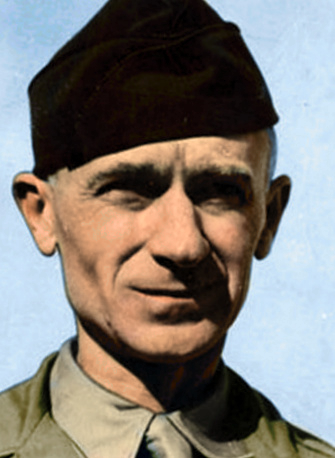
Roving Reporter
By Ernie Pyle
IN THE MARIANA ISLANDS (delayed) – After you take off from one of the island stops crossing the Pacific, your plane climbs noisily and laboriously for about half an hour, then it levels off into steady and less labored flight.
Gradually the intense tropical heat of the ground fades away, and a chill comes over a cabin. Then the flight orderly turns on the heater, and adjusts it until you are comfortable in your light clothes, even without a jacket.
It was after midnight when we took off from the little island of Kwajalein, in the Marshalls, and we were not to stop again until we reached the Marianas.
Passengers are not allowed to smoke until the plane has stopped climbing and leveled off. Then the flight orderly stands at the head of the cabin and shouts in good Navy language “the smoking lamps lit,” and then brings around paper cups for you to use as ashtrays.
About every three hours the flight orderly would wake us up to feed us. Gond food too, and served on trays Just as on the regular airlines.
Frequent feedings
It got to be a joke among the passengers the way they poured food into us. They fed us at every stop, and about every three hours in the air. They nearly fed us to death.
The flight orderly is a sailor who does the same job as a steward on the airlines. We had two crews and two flight orderlies during our long trip, since the same crew stops off halfway for a day’s rest, and a new crew comes on.
Both our flight orderlies were swell boys. There were 16 passengers of us – 12 Navy and Army officers (one a Marine Corps general) three enlisted men, and myself, the only civilian aboard. The orderlies took good care of us, were friendly and willing, treated us all alike, and they weren’t a bit scared of the high rank aboard.
They wore plain blue Navy dungarees and blue shirts, and worked with their sleeves rolled up. Our first one was Seaman Howard Liner of Lubbock, Texas. He used to sell “Dr. Pepper” before he joined the Navy.
36 Pacific trips
Howard has made 36 of these trips across the Pacific, and enjoys it. He gets back to San Francisco frequently, and on his next trip his wife is coming up from Lubbock to see him. Howard always has a little brown pencil stuck behind his ear.
The other flight orderly was Seaman Don Jacobi of San Gabriel, California. He wore a plaited leather belt, and hung from it was a big bunch of keys and a hunting knife in a scabbard. This was his seventh trip.
He seemed quite mature, yet I found he is only 18, and had quit nigh school to join the Navy. His one ambition is to finish school after the war, and go on to college.
It’s mighty tiresome sitting in the same seat on an airplane for nearly 24 hours, even when the seats are reclining ones, as ours were.
The worst part is trying to sleep. You doze for a while and then you start squirming, because you can’t stretch your legs out and your knees start to hurt. Consequently, those who have traveled a lot by air try to find someplace to he down. The floor is good, but a stack of mail sacks is better.
Small size helpful
They had mail piled in the rear four seats, so I got my blanket and started fixing myself up on the mail bags. An Army colonel ahead of me said, “I just tried that, but had to give it up. There are too many square boxes inside the sacks and they stick into you.”
But I went ahead, and being smaller than the colonel, discovered I could sort of snake myself in between the hard places in the sacks. And that way I slept most of the journey to the Marianas.
But one funny thing did happen that I’d never experienced before in flying. The plane had quite a bit of vibration, and when my head touched the plane anywhere, the vibration would carry all through my head.
That didn’t bother me, but for some odd physiological reason, this vibration made the tip of my nose itch so badly I had to scratch it all the time. And thus I dozed the night away, really only half asleep because of the constant necessity for scratching my nose.